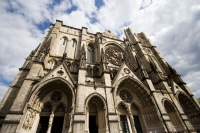
The origin of the food people eat is an important concern for consumers’ health and the well-being of the environment. (Courtesy of Flickr)
By Victoria Borkowski
Have you ever wondered how scientists at NASA develop ways to grow food aboard space shuttles? How about where the “ugly” potatoes and tomatoes go when they arrive in supermarkets? Forget everything you thought you knew about the food in your pantry.
“The Value of Food: Sustaining a Green Planet” is a must-see installation that depicts an often ignored and frightening truth behind where our food comes from.
The exhibit is featured in the Cathedral of St. John the Divine, a New York City landmark worthy of visiting on its own. Throughout its installations placed thematically within the bays and chapels of the cathedral, the exhibit begs the ultimate question: can the way we produce and sell food sustain life for our growing populations?
“The Value of Food” features the work of environmental artists and activists. Besides their paintings, photographs and multimedia pieces in various chapels of the cathedral, the site-specific, interactive works are thought provoking to say the least.
An artificial skeleton of a large extinct bird stands on the main altar of the cathedral — a powerful representation of the fleeting nature of life and of the species we take for granted. A pyramid of soil ingots resembling bars of solid gold stands illuminated within an alcove of the church aisle.
The exhibit is organized according to several themes pertaining to the process of food production: water, soil, seed, farm, market, meal and waste.
But besides these areas of the exhibit, viewers have the chance to observe works of the most prominent land artists and documentary filmmakers like land artist Mel Chin.
Taking on the role of curator and artist of the exhibit, Chin’s “Revival Field Reliquary” features a mini-version of his famous project “Revival Field,” a series of circular gardens in the center of a hazardous waste landfill that he has since been developing within landfills around the world.
Despite the evidence he offers of the toxicity within such landfills, the plants he chose to grow in these areas have been thriving since his first installation of the work in Minnesota in 1991.
Chin’s work, along with the countless other installations, “The Value of Food” offers hope to its viewers. Most importantly, the exhibit thoughtfully revisits the meaning behind the building block of not only human life but of our ever-changing society. Furthermore, it teaches one to notice the process behind growing, harvesting, marketing and selling our food — a lesson worthy of attention.
